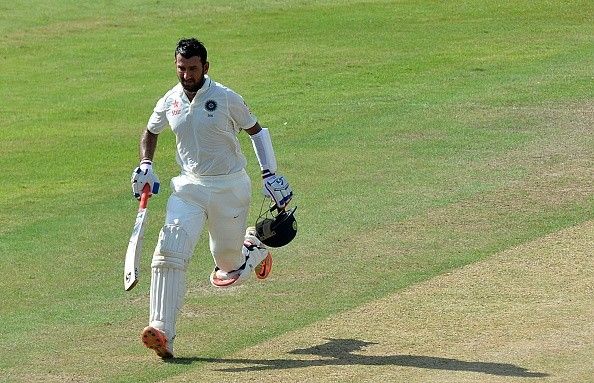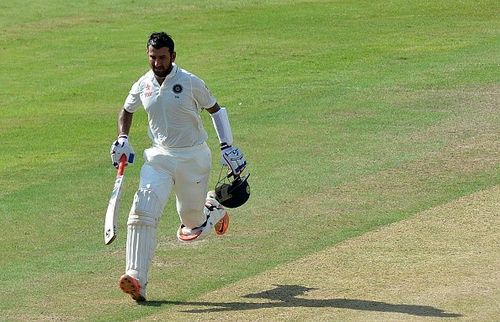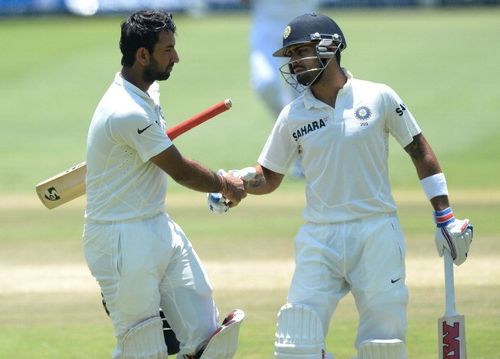
Cheteshwar Pujara - India's best bet at number three

If we can use just one word to describe life, that word would probably be ‘uncertain’. It’s a mixture of good and bad, this thing that we call life. We have good phases, and then we have a few bad ones. Sometimes, when these phases last for periods longer than usual, they make the good appear great and the bad appear horrible. This is exactly what has happened with Cheteshwar Pujara.
His excellent run in Test Cricket lasted for what seemed forever. His bad form, well, it seems to be outliving even that. It’s been pretty fascinating, noticing Pujara’s form with the bat over the past three years. It has never borne any semblance to normalcy, his run scoring. It’s been sky high. It’s been rock bottom. It’s been extreme. It’s been all things bar normal.
The 2014 Boxing Day Test in Melbourne was Cheteshwar Pujara’s 27th match. It’s been 232 days since then, and Pujara hasn’t added another one to his tally. He was stripped off his number three position during the match, and his place afterwards.
Going in to the Melbourne Test, Pujara averaged a decent 39 in the series. Not too good, not too bad. For the first time, his average was not at an extreme. He got a start in the first innings, before he was caught brilliantly by Brad Haddin for 25. He was batting with a fair bit of confidence in this series, but he wasn’t scoring too many runs. Those 20’s and 30’s that he always converted into hundreds when in form. That’s where he was getting stuck.
In the second innings, India were looking to play out the 70 overs remaining and secure a draw. Who better to bank on than Cheteshwar Pujara, the man supposed to have the strongest defence in the Indian team, the man who can bore bowlers to death, the man who bats at number three for India, the man who saves matches for India.
Even when Pujara is not in top form, the sight of him walking out to bat reassures the people of the country, it tells them that there’s nothing to worry, that things are under control. Pujara carries that infectious air of calmness around him. India’s number threes have had it for quite some time. Rahul Dravid had it, VVS Laxman had it. Pujara has it.
But for the first time in two and a half years, for the first time in 22 Tests, Pujara was not the man walking in at the fall of the first Indian wicket. Dhoni had decided to send debutant KL Rahul in at three.
Rahul is not a natural number three, he is an opener who was prepared by the team management to bat at six in Melbourne. And he was a nervous wreck. He tried hooking Mitchell Johnson out of Australia the fifth ball he faced, skied it to first slip. This, when India were looking to play for a draw. It was a strange move by MS Dhoni, but one we had seen four years earlier.
An organised future which turned out differently
Bangalore 2010. India are chasing 207 against Australia in the last of the two test Border-Gavaskar series. The wicket is breaking, the overs left to score the runs are minimal. It’s Cheteshwar Pujara’s debut. He batted at five in the first innings, didn’t score too many runs. This innings, Dhoni promotes Pujara to number three. He is taking Rahul Dravid’s place. Big shoes to fill.
Pujara carries that same air of calmness we would later get used to. And he smiles his way to a matchwinning innings of 72. Just like that, with nonchalance. Since then, he was tipped to be the man taking the number three position once Dravid retired. Bat at six for the time being, score runs, get used to Test cricket and eventually move up to three. It was pretty organised, his future in the Test side. But it didn’t turn out to be this way.
After the South African tour of 2010-11, Pujara fractured his right knee, playing in the IPL. It required reconstruction. The left one had already undergone the same procedure in 2009. He was sidelined for a year. He didn’t play another Test for 18 months.
A lot happened in Indian Cricket during the time. This included whitewashes at the hands of England & Australia, the retirements of Rahul Dravid & VVS Laxman and the emergence of Virat Kohli, the Test match batsman. He missed a lot of cricket. Those bad times, the first intstance of them lasting longer than normal.
But Cheteshwar Pujara was not forgotten. As soon as he was fit, he was selected to captain India ‘A’ on their tour to the West Indies. He played two matchwinning innings on the tour. He did enough to walk straight into a new look Indian team. And be it’s new number three. Those good times had begun. The way Pujara batted in the next year and a half was the stuff of dreams.
In his first innings back in the Indian team, Pujara made a flawless 159 against a sharp New Zealand attack. That just set the tone for the next 14 Tests. He averaged 79. He scored nearly 1500 runs. He had 3 half centuries. He had six centuries, two of them were doubles. Pujara was batting brilliantly, like Don Bradman had just come out of his grave and gone inside Pujara’s body.
Among these innings was a mind boggling 170 at the Wanderers in Johannesburg, probably one of the best innings by an Indian overseas. India were not missing Dravid one bit. They had, in Pujara, a batsman who many believed to be the world’s best. Those good times, they were addictive. India didn’t want them to end, especially with tours to New Zealand, England and Australia lined up for 2014. But, like all times in life, they did.
The horrors of 2014
It started with the low key failures in New Zealand. He averaged a meagre 15 in the two Tests. People felt he was just a bit casual after his monumental run scoring in the past year and a half. Nothing much. They didn’t take it seriously. The fact that all of India’s other batsmen got runs also masked his failure.
What people failed to notice was that there was a pattern to his dismissals. Out swinger, out swinger, in swinger, wicket. While Pujara was sure outside off, it was the ball swinging into him that he had a problem facing. In each of the four innings, he got beaten on the inside of his bat. Trent Boult had found a glitch in Pujara’s defence. James Anderson and Stuart Broad laid it bare in England a few months later. And how!
India’s tour to England was supposed to be a good contest, one which India could win. England had a new team, they were bereft of confidence after a 5-0 Ashes whitewash and series defeat to Sri Lanka at home. India were relying on Pujara and Virat Kohli to see them through this challenge. They were almost carrying the entire burden of the cricket loving Indian population. They had a horror of series, Pujara and Kohli. Kohli averaged 13, Pujara 22.
Cheteshwar Pujara started well at Trent Bridge, he made 38 and 55. Little did anyone know that those would be his highest scores in the series. That magic of 2012 and 2013 seemed to have disappeared. James Anderson and Stuart Broad didn’t just exploit a glitch in his defence, they took it in their hands, laughed at it viciously, threw it to the ground and crushed it under their feet.
He scored only 129 more runs in the series. The inswingers had destroyed his confidence. The defence, so solid a year back, seemed as shaky as Shikhar Dhawan’s. India lost that series 3-1. The one match they won was only because of Ishant Sharma. All of India’s specialist batsmen failed, Murali Vijay and Ajinkya Rahane were the only ones who fared decently. India returned home with their heads down, with their pride dented, with the faith in their batting shattered, with their seemingly flawless number three & four completely found out, completely exposed.
After this tour, Pujara went back to play county cricket for Derbyshire. He scored a century in the three matches he played, but it came on a flat pitch against a sub standard attack. The period of darkness had well and truly set in on Pujara’s career.
There was a three month gap before the Australian tour began. Pujara needed to sort out his technique, he needed to get his sound defence back. In this period, Pujara played club cricket and slowly regained some confidence. But that easy flow to his batting was missing, he was too focussed on his defence.
Virat Kohli had an even worse series than Pujara. But he got back up almost as quickly as he fell. He had dealt with failure in international cricket before. He knew how to handle it. Pujara didn’t. Also, Kohli played limited overs cricket for India. It helped free up his mind of insecurities. He slogged his way back to form during the ODI series against the West Indies and Sri Lanka at home. This was the major difference between the two when they left for Australia. Kohli was back to playing those free flowing shots, Pujara was back to just defending.

In Australia, Kohli scored nearly 800 runs, Pujara only 200. Kohli scored runs because he was looking to attack. Pujara didn’t score so many because he was just looking to survive. Kohli carried that positive mindset out in the middle with him. Pujara didn’t. But he shouldn’t have been dropped. Not for Rohit Sharma certainly.
Back in Melbourne, Pujara walked in at number 6. He blocked and blocked, he blocked for 70 balls, before he was finally dismissed. MS Dhoni held fort at one end and guided India to safety before announcing his retirement from Test Cricket after the match got over. It was very shocking, this announcement. Amidst a host of Dhoni tributes, Virat Kohli was named Test captain. And he spoke only about one thing – aggression.
Why preferrring Rohit Sharma to Pujara is a bad decision
MS Dhoni was a sedate sort of captain. In Test cricket, he preferred consistent players over the enigmatic ones. Cheteshwar Pujara was amongst Dhoni’s favourites for this reason. He was a bit more stable than somebody like Rohit Sharma. Under Dhoni, Pujara was never dropped. Even when he wasn’t scoring runs. Dhoni likes these kinds of players.
But Virat Kohli is different. He prefers players who win you matches single handedly on their day, players like Rohit Sharma. He wants his players to play an aggressive brand of cricket, not get bogged down and always go for the kill. Cheteshwar Pujara is not that knid of a player. Kohli’s philosophy, backed by the equally aggressive team director Ravi Shastri, is the sole reason why Pujara had to make way for Rohit Sharma in the Sydney Test.
It was a bad decision, playing Sharma ahead of Pujara. Although it seems that Sharma is a much more aggressive Test player because of his ODI exploits, that is not true at all. Sharma scores at a strike rate of 51 as compared to Pujara’s 49. That’s not much of a difference. The logic behind playing Sharma was completely wrong. He had scored lesser runs than Pujara in this series. His temperament was questioned more than Pujara’s was. He was not a better test cricketer than Pujara. He was not even in better form.
In Sydney, Sharma scored a chancy half century and secured his place for the next Test to be played in Bangladesh. It didn’t seem right, Rohit Sharma being India’s number three. He failed in that Test, as well as in the first one against Sri Lanka. That stability, that consistency, that air of calmness was missing.
Pujara was not played in the sole Test in Bangladesh or in the first one against Sri Lanka just because he had failed in conditions helpful for fast bowling, conditions completely different from the ones in the subcontinent where India play all their Test cricket for the next two years. It was forgotten by the men who matter, the captain and the selectors that Pujara averages 75 in Asia, that he is still India’s best bet when it comes to tackling high quality spin bowling. He was forgotten in this big hype of aggression that Kohli and Shastri were creating. That air of calmness had no value.
Pujara was dropped due to his mediocre overseas performances. That doesn’t make too much sense if you’re playing in Sri Lanka and have Shikhar Dhawan & Rohit Sharma in your team. Their overseas record is much worse. Their home record is much worse. Pujara is a better player of spin. Pujara is a better Test player.
As India failed to chase 176 against Rangana Herath and Tharindu Kaushal in the first Test at Galle, the clamour to play Cheteshwar Pujara grew louder. It was the first time people were voicing their concerns against his continued exclusion, it was the first time people realised how important he was to India’s chances of winning matches in spinner friendly conditions.
It was the first time people realised that Kohli was wrong in not playing him. Had India won, they probably wouldn’t have realised that. It’s time Cheteshwar Pujara gets back his number three position. There’s no one who is better suited for it. We know what he’s capable of when he’s in form. Big runs. Consistent runs. The kind of runs which help you chase 176 easily.